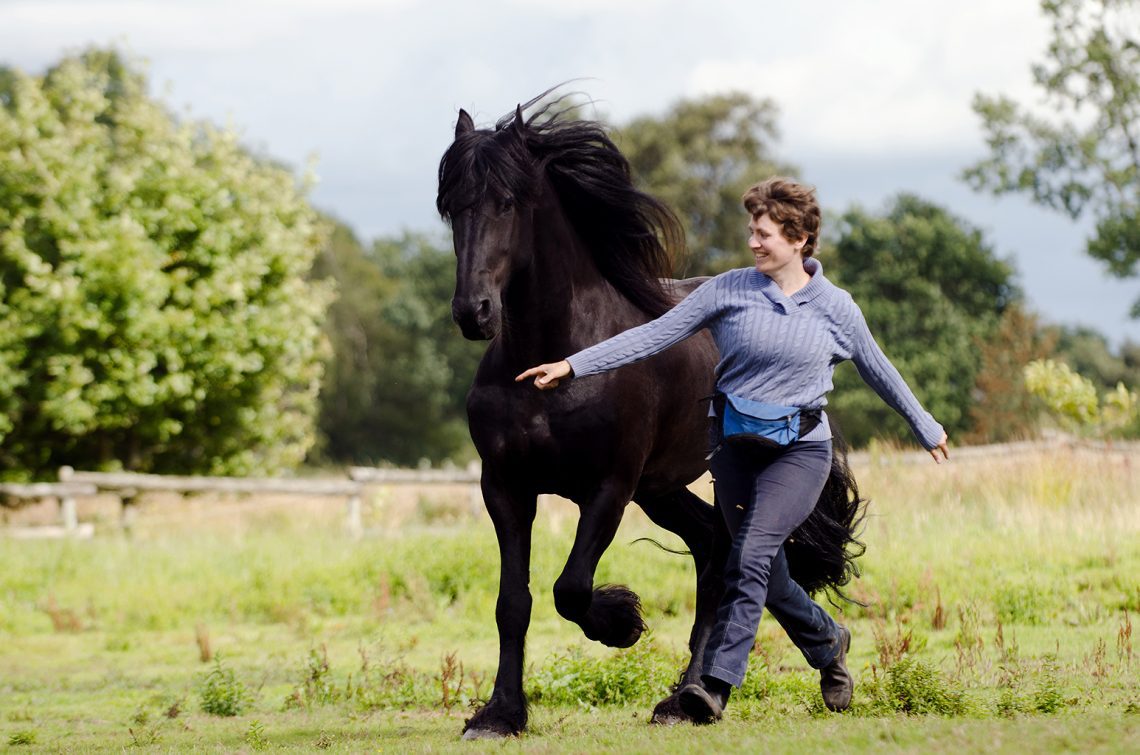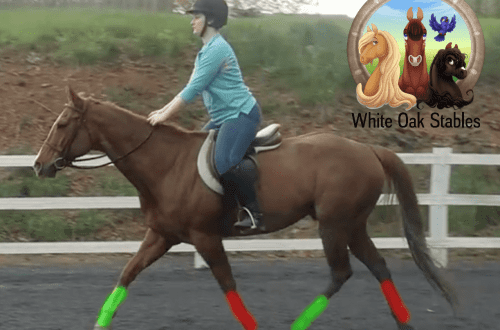
Working with a free horse
Working with a free horse
Work in freedom is used by a lot of trainers, and some of them even demonstrate it in show programs. Every equestrian knows the excellent craftsmen brothers François and Frédéric Pignon and their fine numbers at large – with mares on the first occasion and stallions on the second. A clear system of work in freedom – joint-up – pursuing primarily the goals of disciplining the horse, was developed and demonstrated by Monty Roberts (MontyRoberts join-up). The work of trainers John Lyons and GaWaNiPonyBoy is very interesting. I indicate the titles and names in English transcription, so that it would be easier for you to find their videos on youtube.
I myself have been using freelance work regularly for 12 years now, with different horses and different challenges. Including I had to practice in freedom right in the field, in the middle of the herd.
The main goalsfor which work in freedom can be used are:
1. Motion.
2. Preparation for the race.
3. Working out a wide, active movement in the absence of fields and the possibility of grazing in a herd.
4. Discipline and relationship reset.
This list could be expanded by preparing for the show, performing tricks in the wild, equestrian agility and, in principle, any other types of spending time together with your horse in the “freedom” format. However, as practice shows, it is the goals outlined above that are the most common.
Conditions and tools for working in freedom
1. Ideally – a barrel or a forerunner. But when the ideal is not achievable for one reason or another, you should not put an end to work in freedom in advance. You can also use the parade ground, arena or levada. The presence of corners will complicate your work at first, but by no means nullify it. Too small a barrel is also not very good: if the horse, not yet understanding your requirements, shows aggression, you may be in unnecessary danger. In addition, active movement in a very limited space can cause damage to the joints, ligaments and tendons of the animal, like any other work with an unprepared horse on a small volt. Therefore, in my opinion, more space to start working in freedom is better than less.
Critical (first of all, for you!) will be ground condition, because in the early stages of working in the wild, you will most likely have to move quite actively to control the horse. Deep, viscous ground will not help: the horse will outperform you, which is not what you want.
2. Beach or rope. The Pony Boy we mentioned above, like many “cowboy” trainers, uses a rope. This is partly a tribute to tradition, partly it is convenient, but there is one more nuance: if your horse is afraid of a scourge, start by using a rope – this will make everyone calmer and easier. If rope is your choice, a thick rope with a tassel at the end is your best bet (you can find this in the western gear range).
If you make a choice in favor of a scourge, then it should be a good, light scourge, and not the first one that came across in an equestrian store. From a heavy scourge, your hand will get very tired.
If you have a sensitive and light horse that just needs to hear the click of a whip, a driving whip may be right for you.
Consider the features of work in freedom in solving individual tasks identified above.
1. Motion.
If you decide to start free-riding a horse, which for some reason (age, state of health) is contraindicated in any other load, certain conditions must first be met.
First of all, a horse going out to practice in freedom should not take off with a rocket, tearing off its muscles and tendons. Therefore, starting such training with a stagnant horse is not the best option. It is most convenient to start such classes with a horse that has walked enough or has already worked.
The opposite problem arises when the horse, after leaving, stands upright, and you, trying to make it move, exercise yourself until you lose strength. A plus in such work can be seen only if you consider it as fitness for yourself.
These two extreme options are the most common difficulties, because of which many immediately refuse to study at large.
These problems are solvable, but you will need to spend some time and effort in advance to teach the horse to understand and obey you: to start and stop moving on command, in a certain direction and in a certain gait.
Despite the seeming simplicity of these actions, the ability to control the horse with your voice, at a distance and non-contact is more of a problem for a person, not a horse. Because for a horse this path is just more natural and understandable, because it is based on the principles of communication between horses. It can be psychologically difficult for us humans to get used to the idea of controlling a horse like this from a distance. But it is quite possible to learn this.
2. Taxi.
The work of a horse in freedom to prepare it for a race is a very common (but, unfortunately, mostly not yet in Russia) type of training. It involves a riding program in which no one is in a hurry to go anywhere, focusing on reducing the stress from this procedure for both the horse and themselves. In this case, work in freedom has a number of advantages over the traditional “start” on the lunge.
Firstly, young horses are very fond of working in freedom: in it they see a certain game component that should not be abandoned (of course, while maintaining the necessary discipline). In free flight, a horse can express its feelings and relationships in the hope of being understood by a human, which is psychologically extremely important for such a super emotional animal as a horse.
Secondly, as we said above, such a variant of developing a common language with a horse – in the truest sense of the word! – will be the most natural and easy for her. The horse will learn certain vocal commands, and you will learn to control your body better – his commands for a horse that naturally has only a second signaling system (non-verbal communication) will always be primary.
Thirdly, you will be able to win respect and obedience from the horse gently, without undue psychological and physical pressure. This will become a solid foundation for your future relationships and interactions.
Fourthly, you will save the fragile musculoskeletal system of a young horse from the increased load on the joints and ligaments, which it inevitably receives in the mode of regular lunging.
Fifth, by actively moving in a limited space, during your sessions, the horse will learn to coordinate and deal with his legs. This will greatly facilitate the next stage of the ride – lunging.
The list could go on, but I think the five arguments in favor of going free to train for a ride are enough.
3. Practicing a wide, active movement
Not all of our horses that are in the process of training have the opportunity to move a lot and actively in the fields. But this is precisely what they often lack for proper physical development, for some kind of qualitative “jump” forward. This is well understood by experts. That is why the Spanish Royal School in Vienna, located right in the city center, has made an excellent simulator for the work of stallions in freedom. They do it every day for 30 minutes. And besides, for the summer the school sends horses “on vacation”, to the fields.
If we don’t have any simulators, no holidays in the fields, or even a springgarten, we have to solve the problem “on the knee”.
How is this task different from exercise? The fact that in this case the emphasis is shifting to helping the horse in solving this or that physical problem, which it (or us) finds difficult to solve in other types of work. And therefore, this type of work is still for horses and people already “advanced” in working in freedom.
For example, with my mare, I ran into a problem that literally made me give up. A fairly large trakene with long levers and a defect in the hock joint (the talus had not matured) under the top tried to fall on the front and sadly row back. It is obvious that the standard attempt to solve the problem with the help of additional means in the form of a dowel or interchanges could only aggravate it: forcibly raising the front in no way activates the buttocks, and we would not get any impulse going through the back …
So I suggested that the horse return to work in freedom, which he knew and loved from the age of two.
The horse not only joined this process with pleasure, but it also diligently introduced into the movement in freedom those elements that it had been trained on the lunge, long reins and under the saddle. She and I easily regulated the rhythm, tempo, the level of the head position (minimum, of course: higher-lower), the activity of the hind legs. By the way, the mare performed the correct passage of the corners herself. Naturally, this became possible because once upon a time changes of direction and gaits were learned by heart.
Have we solved the stated problem with the horse? Yes, and unexpectedly quickly. Under the top, movement forward and uphill immediately began to appear, lightness on the reins, which, as you know, is provided by the activity of the hindquarters and the conduction of the impulse through the back.
4. Discipline and relationship reset.
Unfortunately, there are moments when you feel at a dead end. And there is a deadlock at the level of relations. From there, everything extends to specific work with the horse. Stopping and asking yourself the question: “What am I doing wrong?”, you do not always immediately come to a clear understanding and an unambiguous answer. It would be nice to ask the opinion of the horse.
It is also common for an adult horse to fall into your hands. It happens that from bad conditions, or even the last massacre. The attitude of such a horse to people, the desire to cooperate and trust often leave much to be desired.
In both cases, one should put aside the usual work and take many, many steps back – go out to work out in freedom. Paradoxically, it is this retreat that will give your couple a chance to take a huge step forward. And if, going out to practice in freedom, you give the horse a chance to speak out, he will immediately show and tell you everything that he thinks about you and about your relationship with her. Because – I repeat once again – such a format of communication is the most natural, natural and therefore simple for any horse.
Does the horse even pay attention to you? Do you want to be around? Is your personal space respected? Does she feel calm or does she want to run away anywhere, just not to be in the same space with you? Does it ignore your demands when you can’t control it with traditional controls? The horse’s opinion may not please … However, a thoughtful and horse-loving person will think. And most likely, he will be able to change the situation for the better if he does not try to act by force.
In this case, I will not give examples. Because in such cases everything is the case and is decided purely individually, there are no ready-made recipes.
I hope that with the help of this article you have discovered something new and useful for yourself in such a wonderful form of interaction with a horse as working in freedom.
Nina Bryantseva (purpur), horse owner and trainer.
Assistance to horse owners in education, riding, physical and psychological rehabilitation of your pets.
- Allen Delon 20 March 2017 city
Wonderful article! Everything is very clear and rational! Agree on all points! I’m a hoobik with no experience behind me. For a year and a half of training in freedom, a true friend grew out of a wild filly from a herd, thanks to the trust achieved, the ride passed without stress and questions from the horse, in just three months of a very short exercise (10-15 minutes) the quality of movements changed – they became wide, free, thoughtful. Answer
 purple 21 March 2017 city
purple 21 March 2017 cityThank you! For a horse from the herd, working in freedom, as the first step, was the right choice. Answer
 purple 21 March 2017 city
purple 21 March 2017 cityThank you! For a horse from the herd, working in freedom, as the first step, was the right choice. Answer




